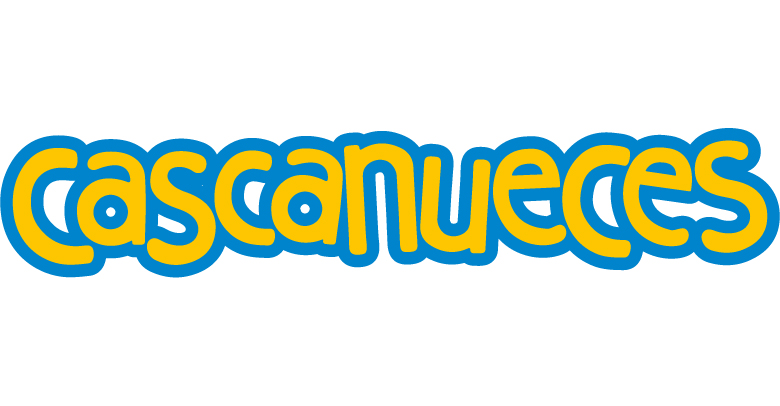Trimox dosages: 500 mg, 250 mg
Trimox packs: 30 pills, 60 pills, 90 pills, 120 pills, 180 pills, 270 pills, 360 pills
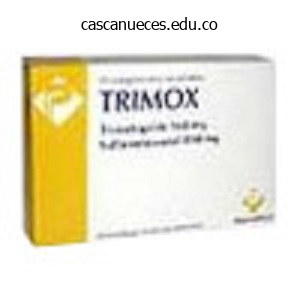
Buy trimox with paypal
The plasty is usually performed in a "three-layer" fashion, by putting a first layer exceeding by 30% the scale of the defect intracranially and intradurally, a second layer intracranially but extradurally, and a third extracranially masking the anterior skull base defect with care to not intrude with frontal sinus outflow. Note the surgical defect on the finish of endoscopic resection with transnasal craniectomy. The white dotted line delineates the defect of the anterior cranium base, and the black line, the defect of the dura of the anterior cranial fossa. Fat tissue can be positioned between the second and third layers as refinement of the reconstruction. In cranioendoscopic resection, an endoscopic strategy is coupled with subfrontal or frontal craniotomy to achieve better publicity from above of a lesion rising extensively at the intracranial degree. Subfrontal craniotomy is associated with minimal retraction of the frontal lobes and is due to this fact currently recommended. After performing the endoscopic part of the operation based on the steps beforehand described to isolate the specimen from under, a coronal incision is carried out far posteriorly to subsequently harvest an extended pericranial flap that shall be used for reconstruction of the cranium base defect. With the assistance of a frontal template, osteotomies are performed along the superior and inferior margins of the frontal sinus, a bony volet together with the anterior wall of the frontal sinus and the superomedial contour of the orbits is eliminated after preplating, and the posterior wall of the frontal sinus is drilled out. Based on imaging findings, the exposed dura is incised transversally and longitudinally far sufficient from the putative extent on each side to check the intradural extension of the lesion. With a diamond bur, the superior part of the ethmoidal-sphenoidal block is isolated, paying attention to precisely cauterize the ethmoidal arteries. The use of the surgical microscope and endoscopes permits transcranial elimination of the surgical specimen with an correct 360-degree management of margins. Many argue that its use is off-label for this indication and can be associated with issues corresponding to seizures, cranial nerve deficits, and even dying. According to Wolf et al, the incidence of problems may be attributed to improper administration when it comes to quantity, focus, and quality. Complications Decreased morbidity and a negligible mortality are generally cited among the primary benefits of endoscopic surgery compared with conventional external techniques. This assertion is supported by every day apply, although there are restricted knowledge in the literature. Perioperative Management 853 Benign Tumors Morbidity of endoscopic surgical procedure for benign tumors is in general limited and mainly contains postoperative bleeding, numbness within the area of innervation of the maxillary nerve, impairment of sinus outflow because of scar formation, and stenosis of the lacrimal pathway when resection has been carried out. Inverted Papilloma Overall, the complication price in sufferers handled for inverted papilloma with a purely endoscopic or mixed approach has been reported to range from 047 to 20%. In our sequence of 212 patients, 198 handled by a purely endoscopic resection and 14 also receiving an osteoplastic frontal sinusotomy, 20 complications (9. For instance, its use might be averted in small lesions, the place the surgeon can simply management bleeding by isolating and clipping the sphenopalatine or inner maxillary artery as a primary surgical step. Other measures corresponding to pre-banking affected person blood or using a cell saver system can be used to decrease heterologous blood transfusions. Note the indications for preoperative embolization in juvenile angiofibroma are more restricted than previously thought. Malignant Tumors Osteoma/Fibrous Dysplasia the difficulty of morbidity after endoscopic removing of fibroosseous lesions has obtained little attention, and has been primarily analyzed in relation to osteomas. In a collection of 22 instances, Castelnuovo et al50 reported ocular issues in the subgroup of three sufferers with intraorbitary extension. All complained of diplopia, which was related to impairment of visual acuity in one patient; signs resolved inside 2 months. Only one patient required endoscopic revision surgery, which was successful in the long run. Juvenile Angiofibroma Intraoperative bleeding is a significant concern for the surgical group involved in the administration of juvenile angiofibroma. In a series of 46 cases handled by endoscopic surgical procedure after embolization of the feeding vessels coming from the external carotid artery, intraoperative blood loss ranged from 250 to 1300 mL (mean 580 mL) and was discovered to be considerably elevated in case of bilateral vascular supply and within the presence of feeding Endoscopic surgery for malignant tumors is associated with a barely elevated morbidity compared with benign tumors, especially when the resection is extended to the anterior skull base or when a cranioendoscopic resection is carried out. The general complication price within the two largest sequence reported,37,38 including patients handled by endoscopic surgery alone or cranioendoscopic resection, was 8. Two cases of fatalities in sufferers with a T4b lesion with in depth dural infiltration handled by cranioendoscopic resection occurred within the Italian series,37 while no case of demise was reported within the M. When a temporary communication between the sinonasal cavities and intracranium is created the advice is to prolong antibiotic administration no much less than till the nasal packing is eliminated or for up to 7�10 days. Other measures to supplement systemic antibiotic therapy have been described corresponding to irrigation of the surgical area or soaking of all reconstruction material used for duraplasty with antibiotic.
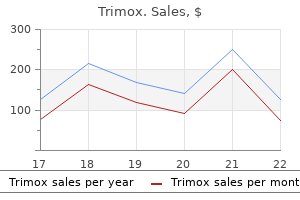
Discount trimox 500mg
The primary analysis of rhinosinusitis leads to expenditures of roughly $3. Children have approximately six to eight viral infections of the higher respiratory tract every year, 5 to 13% of which can be complicated by a secondary bacterial an infection of the paranasal sinuses. Note the widespread cold has been found to be associated with mucosal inflammation in not only the nasal cavity but additionally the paranasal sinuses. It was proven in an early research that the common cold (viral rhinitis) may find yourself in marked and long-lasting impairment of nasal mucociliary clearance function. The common chilly has been found to be associated with mucosal irritation in not only the nasal cavity but in addition the paranasal sinuses. In the literature, most reported research were carried out utilizing human volunteers and experimental animals or concerned in vitro analysis of human tissue or cell strains. Acute Bacterial Rhinosinusitis Rhinosinusitis could be attributable to viruses or micro organism. The prevalence and diploma of antibacterial resistance in common respiratory pathogens are increasing worldwide. The overuse of antibiotics has been reported to have instantly resulted in an elevated prevalence of antimicrobial resistance in Europe. Nasal Vestibulitis Caution the differentiation between viral and bacterial is difficult and may not be very related as a end result of each viral and bacterial rhinosinusitis is usually a self-limiting disease. Based on their calculations, no extra than 13% of patients who offered with symptoms of acute respiratory an infection would have acute bacterial rhinosinusitis; and most probably even it is a gross overestimation of the share. In more critical cases, bacterial infections may result in boils, furuncles, or cellulitis. Occasionally, bacteria can spread backward through the veins to the cavernous sinus, which drains blood from the brain, resulting in a lifethreatening condition called cavernous sinus thrombosis. Nasal vestibulitis might result from nose choosing, excessive nostril blowing, nasal overseas bodies, anterior septal deformity, tumor of the nasal vestibule, and issues following septorhinoplasty surgical procedure, nasal packing, and use of splints. Local cleanings and use of antibacterial (antistaphylococcal) solutions or ointment are helpful. Diagnosis 271 antibiotics have to be used due to the potential complication of cavernous sinus involvement. Diagnosis the evidence-based diagnostic scheme for adults with acute viral or bacterial rhinosinusitis has been launched in accordance with the presence of symptoms and period of disease. A notably challenging task is to distinguish viral from bacterial rhinosinusitis. In most patients, rhinoviral sickness improves in 7 to 10 days; due to this fact, a analysis of bacterial rhinosinusitis requires the persistence of signs for longer than 10 days or a worsening of signs after 5 to 7 days. Symptoms of viral rhinosinusitis, including fever, mimic these of bacterial rhinosinusitis, though the color and quality of nasal discharge-classically, clear and thin. Acute rhinosinusitis Two or more signs, one of which should be either nasal obstruction or nasal discharge (anterior/posterior nasal drip): �� facial pain/pressure �� discount or lack of scent. Viral rhinosinusitis �Symptoms improve in 7�10 days �Yes or no �Clear and skinny Duration Fever Nasal discharge Bacterial rhinosinusitis �Symptoms improve after 5 days �Symptoms persist after 10 days �Yes �Yellow and thick �Same as viral rhinosinusitis �Isolated an infection. However, mucopurulent discharge appears also in 50% of patients with viral rhinitis. Isolated an infection of a frontal or sphenoid sinus is a uncommon and probably harmful condition, often attributable to bacteria, which presents very differently from the majority of cases of rhinosinusitis. According to our current survey in Asia,19 over 73% of physicians (including general practitioners, otolaryngologists, and pediatricians) have completely agreed with this recommendation. The perception for the necessity of radiologic studies causes unnecessary exposure to radiation and elevated well being care costs for patients. Antibiotic remedy ought to be reserved for sufferers with excessive fever or severe (unilateral) facial ache. For initial treatment, essentially the most narrow-spectrum agent energetic towards the likely pathogens (S. The clinical efficacy of glucocorticoids is determined by their antiinflammatory properties and talent to promote epithelial repair. Recently, a double-blind, double-dummy, placebo-controlled study was revealed during which topical corticosteroid therapy was used as monotherapy and compared with antibiotics. Complementary/alternative medicines are extensively used within the treatment of rhinosinusitis, but evidencebased recommendations are troublesome to propose because of the dearth of randomized managed trials and methodological issues in plenty of scientific research and trials. Damage or disruption of mucociliary function as a outcome of viral an infection might be a significant explanation for super- or secondary bacterial an infection.
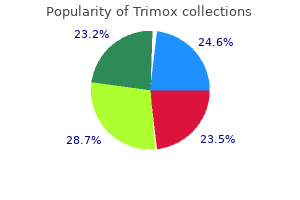
Cheap trimox 500mg on-line
They reported outcomes of 17 years median follow-up on 3,303 patients from this group in two preliminary publications (683,686). In addition, a selection of ailments and drugs are identified or suspected to cause or to be related to modifications of hormones and/or growth elements and thus might affect breast cancer risk (644). Women with the very best mammographic density are at a four- to six-fold higher threat of breast most cancers than ladies with the lowest density (645�647). In this examine, proliferative lesions accounted for roughly 57% of all benign breast diseases. The biologic which means of atypical lobular and atypical ductal lesions is controversial, primarily as a outcome of their pure historical past is unclear (688). A central concern is whether or not or not these atypical lesions are markers of common breast most cancers danger, precursor lesions, or perhaps both. Most research that have examined the laterality of benign and subsequent malignant lesions have discovered that only about half of the invasive breast cancers are in the same breast during which the atypical hyperplasia was beforehand identified, suggesting that these lesions are markers of generalized danger (689). However, data are limited on laterality with regard to the kind of atypical lesion. Although knowledge are restricted, two impartial studies report that atypical lobular and ductal hyperplasias may be completely different, in that atypical lobular hyperplasia may in reality increase the danger of breast cancer in the same breast as the benign lesion (687,690). There are additionally suggestive studies that metformin use could improve breast cancer prognosis, though studies to date have been comparatively small. Thyroid Cancer There have been reports that girls with a prognosis of thyroid most cancers are more doubtless to develop breast cancer than women without such a analysis; this affiliation was first famous in 1966 (696). In contrast, a large potential study (702), found no relationship with common or heavy use of aspirin in comparability with nonusers. In distinction, potential cohort and randomized control knowledge support a protective effect on breast most cancers recurrence and survival (706). Hyperinsulinemia, as occurs in adult-onset diabetes, might promote breast most cancers because insulin may be a growth factor for human breast most cancers cells (691). Many studies have lacked details about the kind and severity of diabetes, making the interpretation of the varied findings troublesome (644). Recently, there was interest in the potential protecting results of metformin, an insulinlowering agent used to deal with diabetes, on cancer risk (693). A meta-analysis of seven studies reported a 17% decreased danger of breast most cancers evaluating diabetics handled with metformin to ladies with diabetes handled with different therapies (694). A higher understanding of the pathway involved and research that can tease apart the effects of Statins A rising body of literature means that statins have antitumor activity by interrupting cell-cycle development and inducing apoptosis. Statins are a class of lipid-lowering medicine prescribed for the prevention of heart problems. However, this association with lipophilic statins has not been confirmed in other large population-based studies (710�712). Further analysis of particular courses of statins and long-term use are necessary. Pregnancy-related Conditions A history of eclampsia, preeclampsia, or pregnancy-induced hypertension has been related to a reduced threat of breast most cancers in parous girls in no less than three case� management research (713�715) and one cohort research (716). Further, ladies born to mothers who had preeclamptic pregnancies additionally seem to have lowered risk of breast most cancers (717). Explanations for these findings have centered on hormone-related components: Women who develop preeclampsia have been found to have relatively low estrogen levels throughout pregnancy, and the lower publicity to estrogens in utero might confer a benefit to the feminine fetus in phrases of lifetime breast most cancers risk discount (717). High ranges of -fetoprotein, a glycoprotein with antiestrogenic properties, are associated with preeclampsia and thus may mediate the association between preeclampsia and decreased breast cancer risk in female offspring (717). Future epidemiologic research of this matter must management adequately for probably robust confounders such as alcohol use and weight problems, which may be associated with use of antidepressants, and will depend on an objective evaluation of treatment utilization, as a outcome of cancer cases could additionally be more likely to recall medication use than noncases. Further, the indication for antidepressant use might itself be related to increased most cancers threat, and melancholy could also be an early symptom of occult cancer. Cytotoxic drugs, used in the remedy of cancer, may exert their own carcinogenic results. One category of cytotoxic medication, alkylating agents, might result in an increased danger of stable tumors, including breast most cancers, although evidence for this speculation is weak (741).
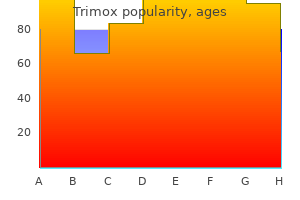
Buy trimox 250 mg mastercard
Through this three-layered closure, the frontal sinus is securely isolated from the nasal cavity and the ethmoidal cells, respectively, and development of mucosa into the sinus with the associated risk of mucocele formation is prevented. Abdominal harvested fat is placed by items into the frontal sinus, held along with fibrin glue, until the sinus cavity is completely filled. Finally, the periosteal bone lid is replaced and fixed with absorbable threads, wire sutures, or miniplates. At the top of the operation, the scalp flap is flipped back into place, two suction drainages are inserted, and the coronal incision is closed with single-stitch sutures. If reconstruction of the bony brow is needed, many alternative grafts and implants can be utilized. There are autogenous bone and cartilage grafts, such as rib, scapula, iliac crest, calvarial bone (inner and outer table), and calvarial bone pedicled at the temporalis muscle. There are also alloplastic materials, such as titanium mesh or plates, polymethyl methacrylate, porous polyethylene, ceramic (hydroxyapatite, carbonated apatite), and biocement (Bioverit). In our expertise, autogenous calvarial bone has been proven to be the most suitable materials for the anterior frontal sinus wall. Usually, the graft is taken extra anteriorly and medially if a flat portion of bone is required, and more laterally and posteriorly if a curvilinear piece is needed. For the transfer of calvarial bone grafts, three methods exist: splitthickness calvarial graft, single-table calvarial graft, and calvarial bone flap. Patients ought to be adopted at 3-month intervals within the first year to examine for instability, resorption, and infection of the reconstructed region. Indications Malignant anterior cranium base tumors with out and with intradural extension. Complications Infection of the calvarial graft has been reported as occurring in 1. The periorbit is dissected from superior, medial, and lateral walls and can be exposed again to the apex. The define of the opening must be planned relying on the scale of the frontal sinus and the extent of the tumor. Osteotomies are carried out by an oscillating saw throughout the frontal bone, down to and alongside the orbital roofs, down the medial orbital wall, and alongside the nasomaxillary grooves simply anterior to the lacrimal crest. Using chisels, the nasofrontal phase, together with the whole frontal sinus, is elevated beneath direct imaginative and prescient, liberating the dura. Therefore, the dura over both frontal lobes is incised, adopted by ligation of the sagittal sinus and dissection of the falx cerebri, which is finally cut. Subsequently, one has a good view over the olfactory grove with each olfactory bulbs and the tumor. With frontal lobe safety by surgical dressing, exposure could be prolonged all the means down to the optic chiasm. Tumor elimination is then performed by osteotomies of the anterior skull base laterally at the junction to the orbital roof and caudally on the planum sphenoidale underneath direct vision and protection of the Subcranial Approach According to Raveh the subcranial strategy was first launched by Raveh et al for treatment of traumatic disruption of the anterior cranium base and printed in 1981. This is achieved by dural detachment from under with virtually no frontal lobe retraction, the avoidance of facial incisions, and adequate dealing with the paranasal sinuses, particularly cranialization of the frontal sinus. Caudal and lateral tumor extensions involving the nasal cavity, maxillary sinus, soft palate, and epipharynx are uncovered by the same subcranial anterior route, obviating the necessity for conventional transfacial approaches, corresponding to lateral rhinotomy and midfacial degloving. After complete publicity, osteotomies, and intracranial dissection, tumor elimination can be achieved en bloc quite than in a piecemeal trend. For reconstruction of the cranium base defect, we recommend several layers of fascia lata (at least two, best three). The first layer of the simultaneously harvested fascia lata is tacked beneath the perimeters of the dura and thoroughly sutured in place. The repaired dural defect is then coated with a second layer of fascia applied towards the entire undersurface of the ethmoidal roof, sella, and sphenoidale space. If the medial orbital walls have to be reconstituted, both fascia lata or Tutoplast fascia lata can be used.

Order 250mg trimox amex
Printed material and handouts with info that the affected person can take in at home are also important. Indeed, in a recent research, the standard of printed handouts and the knowledge gathered from the Internet have been the components most strongly correlated with total patient satisfaction with the consent process. Anatomy of the Bony Pyramid the bony vault or pyramid is the upper one-third of the nostril and is shaped by the nasal bones and the ascending (frontonasal) strategy of the maxilla. Visible are the bony vault, consisting of the nasal bones and the frontonasal strategy of the maxilla, and the cartilaginous pyramid, consisting of higher and decrease lateral (alar) cartilages. Nasal Bones the nasal bones are cephalically hooked up to the frontal bone, laterally to the ascending means of the maxilla, medially to each other, and posteriorly to the septum. Their caudal end overlaps for a few millimeters the upper lateral cartilage, like a roof tile. Caudally and laterally, they kind, together with the ascending process of the maxilla, the pyriform aperture. Anatomy of the Cartilaginous Pyramid 2 the decrease two-thirds of the nose are shaped by the cartilaginous pyramid. This is a unified, winged structure that features the higher lateral cartilage and the cartilaginous septum, which articulate with each other in a T- or Yshaped configuration. Surgical Anatomy of the External Nose 419 Scroll of cephalic edge of lateral crus of alar cartilage. The inner valve is created by the convergence of the septum with the higher lateral cartilage at the stage of the head of the inferior turbinate corresponding to the supratip breakpoint or melancholy. This is the narrowest part of the higher airway, and any degree of narrowing of this angle can lead to nasal obstruction. This area is also important histologically, because it constitutes the interface between the (external) squamous epithelium and the (internal) nasal mucosa. Tips and Tricks One of the roles of spreader grafts is the widening of the angle shaped by the articulation of the septum with the higher lateral cartilage. Lateral and caudally to the lateral crura, fibroareolar tissue lies between them and the pyriform aperture, while laterally and cephalically, there are a quantity of small accessory cartilages. More cephalically (between the nasal bones and the pyriform aperture), there are a couple of sesamoid cartilages. The lateral crus is the widest part of the alar cartilage and is tightly adherent to the overlying nostril pores and skin. Caudally, the upper lateral cartilage articulates with the alar cartilage in the scroll area. Usually the cephalic edge of the alar cartilage overlaps the caudal edge of the upper lateral cartilage, though a number of configurations have been described. The alar cartilage is thus comprised of the medial, middle or intermediate, and lateral crura. They type two arches, with the medial crus converging in the midline and thus forming the columella, and the lateral crus supporting the lateral wall of the nasal vestibule. The medial crura converge in the midline (columellar segment of the medial crura) and diverge extra inferiorly, towards the nasal backbone (medial crural footplates). The middle crus consists of the domal section, containing the tip-defining level, and the lobular section. Tips and Tricks the domal section of the intermediate crus of the alar cartilage can take various shapes, and its configuration defines to a large extent the shape of the nasal tip (boxy, bifid, and so forth. The area cephalic to the tip is called the supratip space and the realm just below it, the infratip. The domal segment of the intermediate crus and the angle of the medial crura and their approximation of the domes are all necessary factors that define the tip form, rotation, and projection. The projection and rotation of the tip are regulated by the relative length of the medial crura (anterior stand, A) and the two lateral crura (lateral stands, B). Tips and Tricks Endonasal rhinoplasty might result in lack of tip assist by disruption of the scroll space through an intercartilaginous incision, whereas external rhinoplasty disrupts the attachment of medial crura to the septum, the interdomal ligaments, and the soft tissue envelope. Note There are several main and minor tip help mechanisms: � Major tip help mechanisms � Attachment of medial crura to the septum � Resilience of the alar cartilage � Attachment of cephalic alar cartilage to caudal upper lateral cartilage (scroll area) � Minor tip support mechanisms � Interdomal ligaments � Cartilaginous and membranous septum � Anterior nasal spine � Skin and delicate tissue envelope � Lateral crural attachment to the pyriform aperture Anatomy of the Septum the nasal septum consists of a bony half posterosuperiorly (perpendicular plate of the ethmoid bone and vomer) and a cartilaginous half anteroinferiorly (quadrilateral cartilage). It is connected posteriorly to the bony septum and posterosuperiorly to the nasal bones. A approach to perceive the assist of the tip and the way totally different methods can produce completely different results in phrases of positioning of the tip is the tripod theory, as described by McCollough and Mangat in 198137 and further refined using the cantilever mannequin lately.
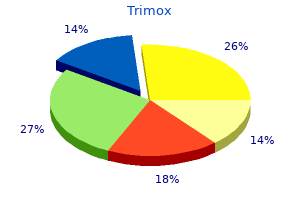
Trimox 250 mg with mastercard
Spreader grafts can be utilized to widen an Management of the Lower Third of the Nose: the Nasal Tip 445 a b c. They can prolong from the nasal bones all the best way all the means down to the nasal tip or can be fastened solely within the middle third of the nostril. Management of the Lower Third of the Nose: the Nasal Tip A practical way of planning surgery on the decrease nasal third of the nostril is by having a clear understanding of the tripod and pedestal concepts. The relationship of those three anatomical constructions is what provides form to the nasal tip9 (see additionally Chapter 23. Things that have to be taken into consideration are the shape, width, length, strength, and current asymmetries on any of the limbs of the tripod. The power of the pedestal have to be evaluated, as nicely as its size and its position over the nasal backbone. When work goes to be carried out on the decrease third of the nose, the nasal base must be stabilized earlier than any tip work is finished. A steady pedestal will present a solid structure to be in a position to place grafts in a proper fashion. This will permit the surgeon to outline the rotation and projection of the nasal tip and placement of the nasolabial angle. Techniques used incessantly are the columellar strut and the caudal septal extension graft. Management of the Lower Third of the Nose: the Nasal Tip 447 Columellar Strut � Corrects buckling or asymmetries that might be discovered within the medial crura the columellar strut is used in most rhinoplasties to maintain the prevailing projection and rotation of the nasal tip. The cartilage ought to be as straight as potential; its length and width will depend upon the needs of the affected person. A pocket must be dissected between the medial crura and the graft fastened in place with absorbable sutures. The superior portion of the graft ought to be reduce 1 to 2 mm under the prevailing domes. It is indicated in sufferers with � � � � Acute nasolabial angles Tips with poor projection Caudal septa which are weak and quick Inadequate alar/columellar relationships11,12 A relatively straight piece of cartilage is needed for this type of graft. The ft of the medial crura are then mounted to the caudal fringe of this graft, and the peak of the nasal tip is ready depending on how a lot tip rotation and projection the patient needs. Once the pedestal has been strengthened properly, the nasal tip lobule could be addressed in a proper fashion, and tip grafts could be placed understanding that with a stable base, reliable long-term outcomes can be achieved. The ones that are used most routinely are the lateral crural steal, dome-defining, transdomal suture-narrowing, and double dome. Lateral Crural Steal the lateral crural steal might be some of the helpful strategies as a outcome of it helps enhance rotation and projection in in any other case undefined bulbous ideas. The vestibular pores and skin is dissected at and across the dome area; the model new lateral position of the domes is marked, and a nonabsorbable 5�0 continuous transdomal mattress suture is positioned, fixing the domes in their new position. This method rotates the tip superiorly, will increase projection, and creates a more triangular base. Contouring the Nasal Tip Tip-defining methods in rhinoplasty are always a problem. Techniques should be conservative and predictable, reserving the more aggressive techniques for more outstanding deformities. Surgical methods of the nasal tip can be divided into totally different classes: � Suturing strategies � Techniques by which cartilage is resected � Techniques by which the alar cartilage is split (incomplete strip procedures) � Techniques using grafts Dome-defining Sutures Dome-defining sutures are placed on the present dome space. Special care must be taken to stop pinching of the domal space with a resulting convexity of the lateral crus and buckling. It overlaps the caudal fringe of the nasal septum and is fixed in place with 4�0 Vicryl sutures. The identical suggestions for the transdomal suture-narrowing approach are relevant. Transdomal Suture-narrowing Technique the transdomal suture-narrowing approach is used in broad, boxy ideas that have an elevated interdomal distance.

Buy trimox american express
The endoscopic endonasal, transsphenoidal method provides a superb panoramic view of the sphenoid sinus and of the sellar and parasellar regions, with intraand extracapsular visualization utilizing straight and angled endoscopes, preservation of sinonasal operate, lowered hospital stay, and elevated affected person consolation. Improved visualization, avoidance of mind retraction, quicker restoration, lack of external scars, and the power to directly access tumors with minimal injury to crucial neurosurgical structures are amongst its apparent benefits. This is mirrored in improved outcomes in phrases of greater charges of gross macroscopic tumor elimination and normalization of hormones (in secreting adenomas) and decreased hospitalization requirements. However, it presents surgeons with a number of challenges, including a steep learning curve, difficult reconstruction necessities, and the need for a true staff method. The transsphenoidal approach to the sella evolved from Indications/Patient Selection 739 affected person outcomes in contrast with the traditional microscopic strategy. Despite their benign nature, they have a tendency to infiltrate and cling to adjoining buildings, making their complete elimination troublesome. Meningiomas Indications/Patient Selection the differential diagnosis of sellar lesions is offered in Table 38. The most typical are pituitary adenomas, craniopharyngiomas, meningiomas, Rathke cleft cysts, and pituitary apoplexies. Preservation or restoration of normal neurologic function, including visible acuity and fields 4. Achievement of an entire pathologic analysis Meningiomas normally come up from the tuberculum sellae or diaphragma sellae and should trigger complications or visible disturbances as a outcome of the close relationship to the optic nerves and chiasm (for a more intensive dialogue of anterior cranium base tumors and approaches, see Chapter 40). Rathke Cleft Cysts Rathke cleft cysts are normally small cystic lesions derived from Rathke pouch remnants, causing headaches. Pituitary Adenomas Craniopharyngiomas Craniopharyngiomas are slow-growing tumors originating from remnants of the Rathke pouch (see Video sixty two, Endoscopic Removal of Retrochiasmatic Craniopharyngioma, Pituitary Transposition). Depending on their location and measurement, they might current with complications, visible loss, pituitary Table 38. Pituitary adenomas are benign epithelial tumors derived from secretory cells of the anterior pituitary gland (adenohypophysis), which are categorised according to the immunohistochemical expression patterns of hormones. They are divided into microadenomas (tumors 10 mm in size) and macroadenomas (10 mm). Nonfunctioning/Inactive Adenomas Pituitary adenomas with out hormonal overproduction are referred to as nonfunctioning or inactive. Mechanical compression of the conventional pituitary could cause pituitary dysfunction, and strain on the encircling constructions may be associated with a big selection of signs: strain on the optic chiasm, for example, often produces the classic bitemporal hemianopsia. Extensive suprasellar extension can lead to obstruction of the foramen of Monro, leading to obstructive hydrocephalus. Headaches occur regularly and may be brought on by compression or stretching of the sellar diaphragm or dura. The majority of such patients are ladies presenting with secondary oligoamenorrhea, infertility, and (less often) galactorrhea. The measurement of pituitary adenomas is normally proportional to the diploma of prolactin elevation. Prolactin is underneath inhibitory control by dopamine from the hypothalamus; due to this fact, any mass effect on this space may produce increased prolactin ranges, known as the stalk effect (due to disruption of dopamine transport down the pituitary stalk). However, in such instances, prolactin levels tend to be a hundred g/L, while nearly all of macroprolactinomas current with ranges 200 g/L. The remedy of prolactinomas is primarily medical (dopamine agonists), with good results (90% response rates). Dopamine agonists (bromocriptine, cabergoline) normalize prolactin ranges and cut back tumor size, thereby restoring imaginative and prescient even in the case of large tumors with extreme visual loss. The clinical results of hypercortisolism are the identical: truncal obesity, hypertension, muscle weak point, amenorrhea, hirsutism, stomach striae, glycosuria, osteoporosis, and in some cases psychosis. Demonstrating increased concentration of plasma and urinary cortisol makes the prognosis. Symptoms might arise in cases of large tumors with chiasmal compression or hormonal deficiency of one or more hormones because of compression of the normal pituitary gland.
Best 250 mg trimox
Note the multi-lobulated margin (arrow) and heterogeneous internal echotexture, which should prompt a biopsy. If fibrocystic adjustments are found, affected person reassurance normally resolves the affected person grievance. An abscess is round or irregular in form with indistinct margins and elevated vascularity. Aspiration could be each diagnostic and therapeutic if all or a lot of the fluid could be withdrawn (23). Nipple Discharge Nipple discharge is a frequent criticism in the breast imaging division. Ultrasound has been used along side mammography to assess for an intraductal mass that could be the purpose for discharge from a single duct, similar to a papilloma. Ultrasound may additionally be useful instantly following a galactogram to assess for an intraductal mass. The affected person is transferred to the ultrasound suite with the galactogram cannula in place, so the offending duct may be persistently full of contrast that may define the intraductal mass. If the mass can be identified with ultrasound, it could then be biopsied utilizing ultrasound guidance, thereby avoiding blind surgical excision. The "stepladder signal" is the place the native wall of the implant can be seen floating within the silicone, which has been confined by the implant capsule. Extracapsular rupture, the place silicone is seen outdoors the confines of the implant capsule, is described as an echogenic mass with echogenic shadowing, generally identified as a "snowstorm" look in both the breast tissue or in axillary lymph nodes. Careful sonography over the realm of palpable concern confirms the presence of the valve, and the affected person can return to screening mammography. Evaluation of the axilla on the time a suspicious breast mass is discovered is helpful to assess for the presence of locally advanced disease (19). Lymph node involvement continues to be an necessary prognostic extent of Disease Ultrasound may be useful to outline the extent of disease when a affected person has a suspected or identified breast most cancers. Identifying multicentric disease, skin involvement, or adenopathy can help with surgical administration and staging. Many practices perform focused sonography; nevertheless, the ultrasound can be expanded to the complete breast and axilla if a suspicious mass is found. The information of axillary lymph node involvement prior to surgical procedure, nonetheless, may not be essential since a sentinel lymph node biopsy will be carried out at the time of breast conservation surgery. A few facilities evaluate the supra- and infraclavicular lymph node basins on the time of discovery of a suspicious breast mass (25). They concluded that suspicious infra- or supraclavicular lymph nodes have been a helpful adverse prognostic factor and advocated routine sonography of these nodal basins in patients with regionally superior breast most cancers. Others have advocated analysis and, if potential, fine needle aspiration of internal mammary lymph nodes, arguing that identified internal mammary lymph node involvement would change radiation remedy (26). The causes for this can be multifactorial: the low likelihood of involved lymph nodes, inexperienced sonographers, uncertain clinical management significance, and lack of dependable cytology for fantastic needle aspiration of suspicious lymph nodes. Summary Breast ultrasound is an important software in analysis of breast complaints as a result of its lack of ionizing radiation and low price. Breast ultrasound is most effective when performed by an experienced operator and used along side mammography. For example, ultrasound can additional characterize a mammographic massasabenigncystorasolidmass. Follow-up of Prior ultrasound Findings An increasingly frequent use of breast ultrasound is in the administration of fibroadenomas, some of the common benign solid lots in ladies. Since these research confirmed a <2% malignancy price (but not 0%), these authors really helpful imaging followup. Meticulous attention to technique and administration primarily based upon the most suspicious imaging characteristic is key to replicate these outcomes. Analysis of sonographic features within the differentiation of fibroadenoma and invasive ductal carcinoma. Breast carcinoma in pregnant women: evaluation of clinicopathologic and immunohistochemical options. Sensitivity, specificity and predictive values of breast imaging in the detection of cancer. The agreement of ultrasound with the pathology specimen falls after neoadjuvant remedy.
References
- Green JJ, Hobbins JC: Abdominal ultrasound examination of the first-trimester fetus, Am J Obstet Gynecol 159:165n175, 1988.
- Loirat C, Noris M, Fremeaux-Bacchi V. Complement and the atypical hemolytic uremic syndrome in children. Pediatr Nephrol. 2008;23:1957-1972.
- Diehl JT, Cali RF, Hertzer NR, et al: Complications of abdominal aortic reconstruction. An analysis of perioperative risk factors in 557 patients, Ann Surg 197(1):49-56, 1983.
- Fellman JH, Buist NR, Kennaway NG, Swanson RE. The source of aromatic ketoacids in tyrosinemia and phenylketonuria. Clin Chim Acta 1972;39:243.


